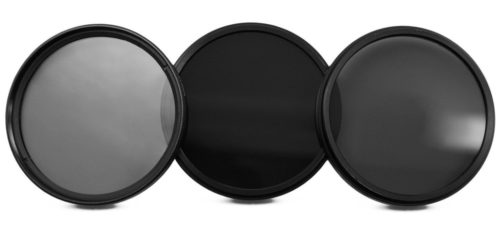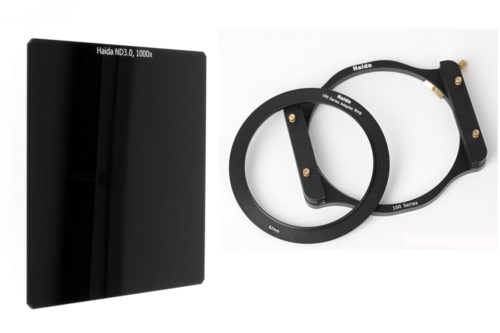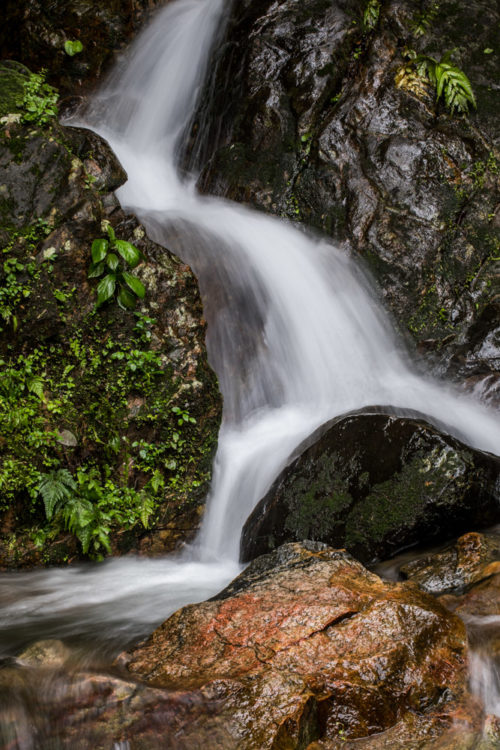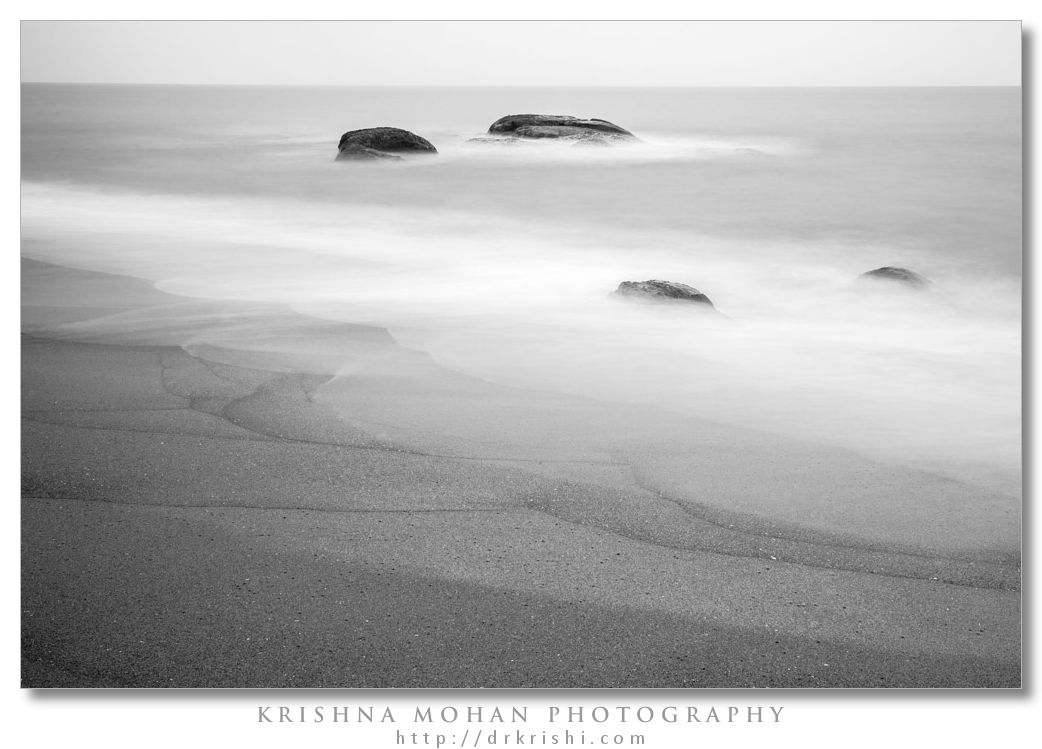
A Neutral Density (ND) filter is a semi-transparent piece of glass that is used to reduce the amount of light entering the camera, enabling a longer exposure time than otherwise possible. This filter also blocks all frequencies across visible spectrum, thereby not introducing any colour cast. That is why it’s called a neutral density filter.
Situations where ND filters are particularly useful include:
- Smoothing water movement in waterfalls, rivers, oceans, etc.
- Achieving a shallower depth of field in very bright light
- Reducing diffraction (which reduces sharpness) by enabling a larger aperture
- Making moving objects less apparent or not visible (such as people or cars)
- Introducing blur to convey motion with moving subjects
Longer exposure times can achieve a wide variety of artistic effects involving movement in the photograph. This includes softening the appearance of turbulent water, blurring waves of blowing grass, or emphasizing motion within a crowd of people.

For full surreal effect, multi-second exposures are usually a must. These can render clouds as streaks in the sky, blur moving people beyond recognition, or make waves appear as a uniform, low-lying mist. However, this depends on the nature of the motion, the amount of subject magnification and the desired effect. The key is lots of experimentation.
Although ND filters are primarily used to achieve longer exposures, a less common application is to enable a shallower depth of field in very bright light. For example, most SLR cameras have a maximum shutter speed of 1/4000 second, so a subject in direct sunlight might therefore require an f-stop greater than about f/5.6 (at ISO 100). With a 3-stop ND filter, one could reduce this to f/2.0 (if your lens is capable of opening so wide) – yielding a dramatic improvement in background blur and subject isolation.

You can buy either screw-on ND filters or a square Filter Mounting Systems. Both are good you can choose them depending on your needs.

If you are buying a screw-on type filter, you should just purchase an ND filter that fits their largest lens, and use what’s called a “step-up adaptor” to have this same ND filter fit on any smaller lenses. This avoids you from having to purchase one for each lens diameter. Advantage of screw-on filters over square or rectangular ones comes down to portability and ease of use. Screw-on filters can be fitted very quickly and there’s no requirement to bring anything else with you other than the filters themselves.

The main benefit of Square filter holder is that you don’t need to get different sized filters to fit different sized lenses. Instead, all you need is a variety of adapters for your filter holder that are specific to the diameter of your lens. The filter holder adapter screws on to the lens, and then the filter hold attaches to the adapter. The adapters are cheap, so it’s not a problem to adapt a large variety of lens diameters to work with a single filter holder and set of square filters. It’s also relatively easy to stack multiple filters together as most holders will have multiple filter slots. This allows you to easily use multiple ND filters simultaneously, or an ND and a graduated ND at the same time. Conversely, stacking multiple screw-on filters together often results in vignetting unless you are using more expensive ultra thin filters. The thinner glass or resin square filters don’t cause vignetting quite so easily, but make sure you put them in the filter slots closest to the lens element.

Variable ND Filters are those whose strength can be adjusted without having to switch filters. I don’t recommend them. Cheaper filters in these produce X shaped artefacts as well as colour casts. Instead buy separate ND filters and stack them to produce higher strength.
Alternatively, polarizing filters can function as 2-3 stop ND filters, but only if one also wants the polarized look, and only when this filter is rotated for maximum effect. Some photographers don’t purchase 2 or 3-stop ND filters for this reason, and instead opt for stronger varieties (such as a 10-stops).
Some cheaper ND filters can introduce a color cast. This can usually be corrected by adjusting the photo’s white balance in post-processing. However, in extreme cases, cheaper filters can introduce color casts which don’t correlate with white balance settings – making color cast removal much more difficult.

ND filters nomenclature is confusing. Various companies use different code to show the strength of their ND filter. Here is the table to simplify them.
| Various Company nomenclature | Amount of Light Reduction | ||||
|---|---|---|---|---|---|
| Lee, Tiffen, Haida | Hoya, NiSi, B+W and Cokin | Leica | Optical density | Fraction | f-stop reduction |
| 0.3 ND | ND2, ND2X | 2X | 0.3 | 1/2 | 1 |
| 0.6 ND | ND4, ND4X | 4X | 0.6 | 1/4 | 2 |
| 0.9 ND | ND8, ND8X | 8X | 0.9 | 1/8 | 3 |
| 1.2 ND | ND16, ND16X | 16X | 1.2 | 1/16 | 4 |
| 1.5 ND | ND32, ND32X | 32X | 1.5 | 1/32 | 5 |
| 1.8 ND | ND64, ND64X | 64X | 1.8 | 1/64 | 6 |
| 2.0 ND | ND100, ND100X | 100X | 2.0 | 1/100 | ?6 2?3 |
| 2.1 ND | ND128, ND128X | 128X | 2.1 | 1/128 | 7 |
| 2.4 ND | ND256, ND256X | 256X | 2.4 | 1/256 | 8 |
| ND400, ND400X | 400X | 2.6 | 1/400 | ?8 2?3 | |
| 2.7 ND | ND512, ND512X | 512X | 2.7 | 1/512 | 9 |
| 3.0 ND | ND1024 (also called ND1000), ND1024X (also called ND1000X) | 1024X | 3.0 | 1/1024 | 10 |
| 3.3 ND | ND2048, ND2048X | 2048X | 3.3 | 1/2048 | 11 |
| 3.6 ND | ND4096, ND4096X | 4096X | 3.6 | 1/4096 | 12 |
| 3.8 ND | ND6310, ND6310X | 6310X | 3.8 | 1/6310 | ?12 2?3 |
| 3.9 ND | ND8192, ND8192X | 8192X | 3.9 | 1/8192 | 13 |
| 4.0 ND | ND10000, ND10000X | 10000X | 4.0 | 1/10000 | ?13 1?3 |
| 5.0 ND | ND100000, ND100000X | 100000X | 5.0 | 1/100000 | ?16 2?3 |

Which ND filters are the best?
The 3-stop and 6-stop are by far the best performers and at the same time allow for the greatest versatility. If you’re shooting golden light (sunset, sunrise, twilight etc.) the 6-stop will always be your go-to ND for 2-4 minute exposures, with the 3-stop coming into play after you’ve hit the 4-minute mark at ISO 100.
If I had to just get one ND filter for landscape photography, it will be 6-stop ND. 2-4 minutes is the ideal exposure range when shooting sunset, sunrise, twilight and other golden hour moments, when shooting at ISO 100 between F11 to F18, a 6-stop ND puts you right squarely in the 2-4 minute exposure range for golden hour.
A 6-stop ND can also more than double exposure time when you drop from ISO 100 to 50, thereby increasing its versatility quite a bit.
By stacking the 3 + 6 you get an effective 9-stops in those rare instances that you need to go that high. This increases versatility while at the same time may introduce a small amount of vignetting between 16mm and 18mm on a full-frame setup.

The 3-stop is the preferred ND filter for 90% of wedding and portrait photographers. This will allow you to control shutter speed below the cameras maximum 1/4000 or 1/8000 and lower your shutter speed to control flash sync more effectively.
If I want to shoot abstract subjects and I’m not interested in shooting golden light, then 10-stop ND is perfect for pushing exposure times out very far in bright or normal light conditions, especially where there’s movement.
Unfortunately, the 10-stop ND cannot be used for sunsets or the sun rises, and it is for this reason the 10-stop should be avoided completely when shooting golden hour light. If at ISO 100 between F11 – F18 with a 6-stop ND puts you in the 2-4 minute range, a 10-stop ND would push the exposure past 8 minutes, which doesn’t work for two important reasons: sensor noise after 4 minutes makes an image essentially useless, and the sunset sometimes doesn’t last that long. The 10-stop ND does however become very useful between 10AM – 4PM, when the light is directly overhead and flat, or in environments such as Alaska or Iceland where daylight can last a full day.


Very useful info Doc Krishi
very nice article. I landed on your web site searching kambala timetable. I recently got a ND 10 filter 🙁 so look like I I better get an ND 3 for normal usage.